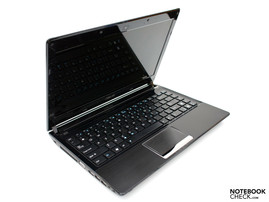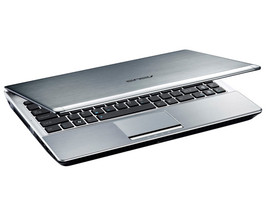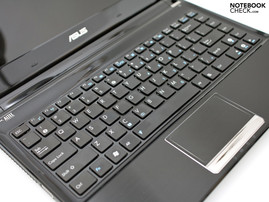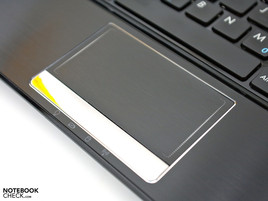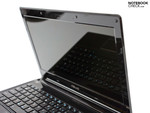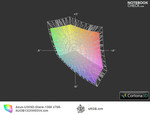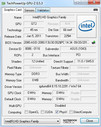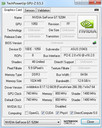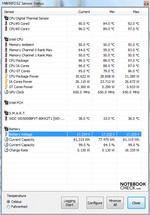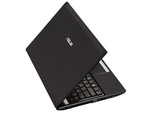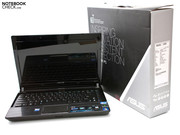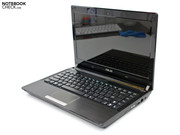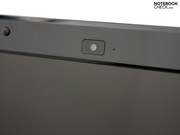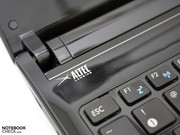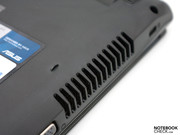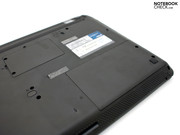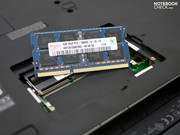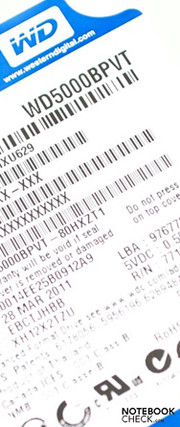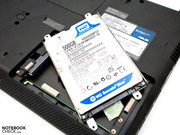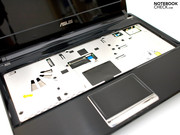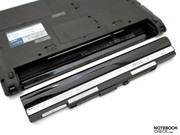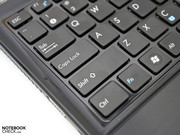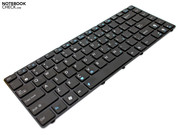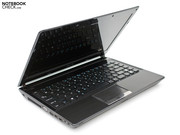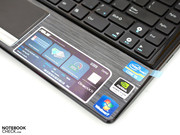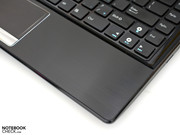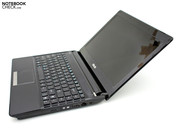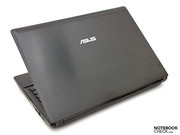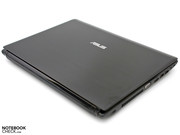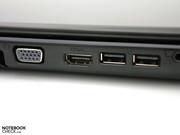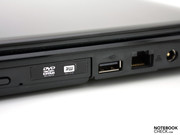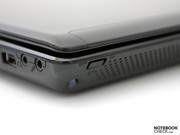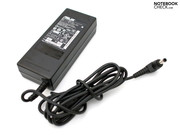Review Asus U30SD-XA1 Subnotebook

Asus is presenting its latest portfolio for this year bit by bit, and the U30SD succeeds the Asus U30JC-A1 reviewed in the beginning of 2010. There is now fast hardware for multimedia routine inside the successor's familiar and quite compact case with an Intel Core i5-2410M and an Nvidia GeForce GT 520M. The glossy 13.3 inch display with a native resolution of 1366x768 pixels, the input devices and the big 8 cell battery don't differ from the predecessor's.
We will not deal with parts about case and input devices since these are based on the same unit. The only difference to the predecessor, in terms of design, is the all-over black case with a faint glitter effect, which looks very elegant and modern. We would refer to our review of the Asus U30JC for more information. The Asus U36JC, as a flat consumer notebook and the Asus P31F, as the business counterpart were up to date until the launch of the new Asus U36JC. However, these devices could also receive a hardware upgrade in near future.
We make use of the model, Asus U30SD-XA1 for this review. The price is maintained even for the new version and the subnotebook is available for 869 euros, including added value tax (RRP). Read in this review how the new model scores in a comparison.
Connectivity
The interface array remains unchanged despite the latest hardware. Beside three USB 2.0 ports, there are two video ports – VGA and HDMI that now also supports the revision 1.4a – a RJ45 network socket, the audios jacks, a Kensington lock slot and a DVD drive that can read and write standard formats. Asus makes it easy on itself by not installing other interfaces, such as eSATA or Firewire. One or more USB 3.0 ports would have fitted well into the devices concept, especially since we already complained about that last year.
The subnotebook's front and side are void of any interfaces except for the cardreader and hardware switch. The interface distribution is mainly concentrated on the case's sides. They are also fairly far front because of the available space and thus, a cable mess beside the device can develop quickly.
Communication
Communication options haven't changed in terms of technical standard. Both gigabit Ethernet (Atheros AR8151) and WLAN standard 802.11 b/g/n are still supported. The installed Atheros AR9002WB-1NG controller with incorporated Bluetooth module is new. According to Asus' US product site, only the older 2.1 +EDR standard is supported, although the revision 3.0 +HS would be possible. A UMTS module or the according preparation for such a solution isn't available despite its mobile alignment.
Supplies
Asus includes the matching 90 watt adapter with power cable, the big 8 cell battery, the usual paperwork, a small cleaning cloth for the display, as well as a driver and tools DVD beside the subnotebook, ex-factory. In view of the price, the scope of delivery is acceptable, whereas there aren't any extras. Microsoft Windows 7 Home Premium (64bit) is pre-installed on the device. A vast amount of freeware programs that are superfluous ballast, with exception of Microsoft Office 2010 Starter and CyberLink Suite, are also part of the package. We would recommend cleaning up prior to daily use.
Warranty
A bonus point is the warranty period of 24 months, including pick up & return service. Asus takes over, as the name already indicates, collecting and return shipping of the defect device. However, there is only a 12 month warranty on the battery.
Input Devices
Details about the keyboard unit, as well as the touchpad, can be found in the review of the equally built predecessor, the Asus U30JC-A1 (QX043V) subnotebook.
Display
We experience the frugality common for many manufacturers in the display field. The 13.3 inch screen, model AUO B133XW03 V4, bids a resolution of 1366x768 pixels at a diagonal of 33.5 centimeters on a high-gloss (glare type) display. Higher resolutions aren't available in Windows 7. However, external monitors can be connected without problems via the HDMI and VGA out. The increasingly popular Full HD resolution of 1920x1080 pixels is only one of many options.
The Mavo Monitor from Gossen records a rather average LED luminosity with a maximum brightness of 179 cd/m2 for the U30SD. Even the average brightness (155.3 cd/m2) and the illumination aren't convincing. An intense decrease of brightness in the screen's left third is striking. The largest deviation is 37 cd/m2 and the difference can partly also be seen with the naked eye.
| |||||||||||||||||||||||||
Brightness Distribution: 69 %
Contrast: 179:1 (Black: 1 cd/m²)
51.2% AdobeRGB 1998 (Argyll 3D)
74.6% sRGB (Argyll 3D)
49.55% Display P3 (Argyll 3D)
The other measuring rates aren't particularly impressive, either. The given contrast of 179:1 is low and the black value of one Candela per square meter is increased. The contrast should be higher and black should be more saturated for pleasant movie watching, whereas these facts are hardly noticed in routine office mode. The screen's reproducible color spectrum is astonishingly quite large. However, there is still need for improvement to reach the sRGB reference color space. The screen is therefore only suitable for professional picture editing to an extent.
The throughout average assessment rates and the high-gloss screen surface limit outdoor use noticeably. The display and its bezel reflect in shady places, albeit working with the sun facing you is still partly possible. The display's brightness isn't of any use in direct light incidence and working is no longer possible. If you're looking for a portable workhorse, you should perhaps wait for the potential update of the Asus P31F subnotebook.
The viewing angle stability confirms the installation of a budget screen. Horizontal rendering stays stable to about 140 degrees and we didn't notice any changes. In comparison to that, a slight deviation of about 10 degrees is enough to show inverting, respectively fading on the vertical plane.
Performance
A compact case and strong computing power aren't a contradiction in the Asus U30SD. The company uses Intel's newest Sandy Bridge CPUs in combination with a dedicated graphics unit from Nvidia. The very popular Intel Core i5-2410M with a clock rate of 2.3 GHz presents the test system's heart. The 32 nanometer CPU's additional specifications are also impressive and AMD currently doesn't have a comparable alternative: 3 MB L3 cache, Hyper Threading technology (2 cores, 4 threads) and the maximum clock rate of 2.9 GHz via Turbo Boost. The CPU places itself in the midfield in view of the updated portfolio.
Asus relies on a graphics unit from the lower midrange, with the Nvidia GeForce GT 520M. It has primarily been designed for multimedia applications and not for gaming. The key data confirm the ranking: a core clock of 740 MHz, a memory clock of 800 MHz and a 1024 MB DDR 3 memory with a 128 bit bus. Nevertheless, DirectX 11 and Shader 5.0 support, as well as the automatic graphics switch, Nvidia Optimus have to be mentioned positively. Together with the installed, updated driver version, ForceWare 266.39, this technology has overcome its initial problems.
The installed Intel Core i5-2410M dual core processor has shown that it provides a good performance in various reviews on Notebookcheck.com. Examples would be the latest Schenker XMG A501 notebook, the Acer Aspire 5830TG or the MSI CX640 with the same graphics. But how will the Asus U30SD-XA1 score in comparison to its predecessor and which CPU is faster?
In Cinebench R10's multi-thread calculation, Asus' little black laptop achieves good 9516 points and therefore finds itself in affiliated neighborhood. The U30JC-A1 with the older Intel Core i5-430M isn't as efficient at the same power loss and only achieves 7802 points (difference: -18%).
The CPU benchmark from the newer Cinebench R11.5 certifies a comparable result. The i5-2410M secures itself a good place in our database with 2.57 points and is ahead of the predecessor, Intel Core i5-430M by 19.5 percent (2.07 points). The Intel Core i7-2620M in the same comparison laptop achieves 2.9 points and is thus 11.4 percent faster. Overall, the processor used by Asus provides a more than sufficient performance for the intended application field.
| 3DMark 2001SE Standard | 20926 points | |
| 3DMark 03 Standard | 12227 points | |
| 3DMark 05 Standard | 9271 points | |
| 3DMark 06 Standard Score | 4754 points | |
| 3DMark Vantage P Result | 2281 points | |
| 3DMark 11 Performance | 570 points | |
Help | ||
Before we start with the pure gaming performance, the Nvidia GeForce GT 520M still has to face the synthetic gaming benchmarks from Futuremark in our test course. Even if this GPU is fairly weak as an entry midrange, the results are interesting because the upcoming AMD Llano APUs will be released onto the market with a similar graphics. The GT 520M achieves good 4754 points in the established 3DMark06 benchmark. The GeForce 310M installed into the predecessor can't keep up with the new technology and lags behind by 32.2 percent (3225 points). The Nvidia GeForce GT 540M as the top model in the multimedia field is faster. The difference is 40.8 percent (8030 points, Acer Aspire TimelineX 4830TG).
3DMark11's GPU benchmark confirms the first results. With 504 points, the GT 520M lags behind the stronger GeForce GT 540M (849 points, Packard Bell EasyNote TS11) by 40.6 percent and is overall at the lower end of our database.
System Performance
The whole package is put through its paces in the system benchmark, PCMark Vantage. Single components can't boost the rating notably (keyword: solid state drive). The Asus U30SD is in a secure midfield with 4636 points. The predecessor with an Intel Core i5-430M is still within a visible range with 4172 point and the difference is a smooth 10 percent. In comparison to that, the Dell XPS 15 with the same CPU and GT 540M scores good 5792 points and is ahead of the test device by 19.6 percent, for example.
| PCMark Vantage Result | 5127 points | |
| PCMark 7 Score | 1772 points | |
Help | ||
A 2.5 inch hard disk with a gross capacity of 500 GB is installed into the Asus U30SD as the memory unit. The Western Digital Scorpio Blue, model WD5000BPVT-80HXZ, works with 5400 revolutions per minute and is addressed by a SATA II connector. Alike entry HDDs with 160, 250 or 320 GBs, the maximum read transfer is average with 70.8 MB per second. Hard disks with 7200 rpm can supply a minor performance increase, whereas the access rates remain almost unchanged. Cutting edge solid state drives, such as the Intel SSD Series 510 or OCZ Vertex 3, with SATA III bus are recommendable in view of the latest technology.
Gaming Verdict
Our graphic cards comparison, as well as our technical FAQ “Computer games on laptop graphic cards” needs new input, which is why we looked closer at a number of games – even though the U30SD naturally can't really be categorized as a gaming laptop.
Among others: Classics from 2004, popular games from the last years, as well as the latest tracks. The Nvidia GeForce GT 520M's results speak for a graphics that is aimed in particular at casual gamers is nevertheless made for uncomplicated multimedia use.
The GPU doesn't have any problems with somewhat older, respectively graphically not very demanding games and they also run smoothly in a high graphics pre-setting for the most part. Beside the free race game, Trackmania Nations Forever and World of Warcraft, the soccer classic, Fifa 11 is one of these games. The Nvidia GeForce GT 540M still has noticeable reserves with a frame rate of 70 fps (+42.3 percent, Acer Aspire TimelineX 4830TG).
In newer games from various developers, the limits are found quickly and a smooth game play is only possible in low, respectively medium graphic settings. To pick an example out of our extensive gaming check: Call of Duty: Black Ops from the Treyarch software developing studios – 38 frames per second are possible in medium with the GT 520M, whereas a short-term freeze screen can turn up. The GT 540M bids a considerably better result in the Medion Akoya P6631 with 56 fps (+32.1 fps).
| low | med. | high | ultra | |
|---|---|---|---|---|
| World of Warcraft (2005) | 196.5 | 67.9 | 28.6 | |
| Half Life 2 - Lost Coast Benchmark (2005) | 149.1 | |||
| Call of Juarez Benchmark (2006) | 18.6 | |||
| World in Conflict - Benchmark (2007) | 148 | 43 | 23 | 8 |
| Crysis - GPU Benchmark (2007) | 72.6 | 29.5 | 16.7 | 3.9 |
| Crysis - CPU Benchmark (2007) | 64.4 | 28.9 | 15.2 | 3.7 |
| Supreme Commander - FA Bench (2007) | 47.2 | 30.7 | 25.4 | 11.7 |
| Trackmania Nations Forever (2008) | 239 | 47.2 | 16.2 | |
| Racedriver: GRID (2008) | 122 | 65.6 | 27.4 | |
| GTA IV - Grand Theft Auto (2008) | 51.6 | 28.5 | 19.6 | |
| F.E.A.R. 2 (2009) | 110.5 | 44.6 | 28.7 | 14.4 |
| Colin McRae: DIRT 2 (2009) | 65.6 | 44.8 | 18.9 | 12.7 |
| Need for Speed Shift (2009) | 24.4 | 21.5 | 17.6 | |
| Resident Evil 5 (2009) | 89.2 | 28.1 | 15.8 | |
| Risen (2009) | 54 | 19 | 14.3 | 8.4 |
| CoD Modern Warfare 2 (2009) | 65.1 | 34.1 | 22.8 | 14.4 |
| Battlefield: Bad Company 2 (2010) | 34 | 25 | 18 | 8.9 |
| Metro 2033 (2010) | 31.1 | 17.1 | 8.8 | 3.6 |
| StarCraft 2 (2010) | 137.2 | 26.8 | 20.4 | 10.3 |
| Mafia 2 (2010) | 36.4 | 27.6 | 23 | 13.6 |
| Fifa 11 (2010) | 252.2 | 123.4 | 79.9 | 40.4 |
| Call of Duty: Black Ops (2010) | 64 | 38 | 30 | 16.8 |
| Crysis 2 (2011) | 30.9 | 20.3 | 16.2 | 5.4 |
| Dirt 3 (2011) | 91.5 | 35.8 | 23 | 12.6 |
Emissions
System Noise
A fan in the subnotebook's left area is still responsible for cooling the new components. The noise level we determined in idle stays within limits and is constant at 33.1 dB(A). The fan is even partly inactive or whirrs along quietly. The U30SD attracts attention during load and is very audible with a maximum of 44.1 dB(A) in our stress test. However, the test device works a lot quieter in most use scenarios, with exception of DVD rendering – 40dB(A).
Noise level
| Idle |
| 33.1 / 33.1 / 33.1 dB(A) |
| HDD |
| 34.4 dB(A) |
| DVD |
| 39.3 / dB(A) |
| Load |
| 39.8 / 44.1 dB(A) |
 | ||
30 dB silent 40 dB(A) audible 50 dB(A) loud |
||
min: | ||
Temperature
The case is convincing with a cool temper in idle and the exterior hardly heats up. The measured rates and even the peak value of 27.5 degrees Celsius are throughout in a blue and thus still pleasant range. The waste heat in the vent's area isn't unusually high, either. Working is not impaired.
Among other things, the CPU's power loss of 35 watts wants to be cooled during increasing load. This results in a noticeable temperature increase on the case. The case's bottom is warm with 39.2 degrees Celsius, whereas the subjective impression is still acceptable. The top, as well as the keyboard's single keys and the touchpad, but with exception of the wrist-rest's sides also heat up noticeably. They could also get unpleasant to use in the long run.
Inside, the processor reaches high temperatures in our stress test (Prime95 + Furmark). However, we couldn't determine a thermal throttling.
(±) The maximum temperature on the upper side is 40.6 °C / 105 F, compared to the average of 35.9 °C / 97 F, ranging from 21.4 to 59 °C for the class Subnotebook.
(+) The bottom heats up to a maximum of 39.2 °C / 103 F, compared to the average of 39.3 °C / 103 F
(+) In idle usage, the average temperature for the upper side is 26.4 °C / 80 F, compared to the device average of 30.8 °C / 87 F.
(+) The palmrests and touchpad are reaching skin temperature as a maximum (34.1 °C / 93.4 F) and are therefore not hot.
(-) The average temperature of the palmrest area of similar devices was 28.2 °C / 82.8 F (-5.9 °C / -10.6 F).
Speakers
The printed logo of the American audio manufacturer, Altec Lansing, awakes hopes for a good sound quality. It is, unfortunately, not confirmed by playing various music genres and the sound is very focused on the high pitches. Deep pitches and basses practically don't exist and rendering suffices for simple podcasts or YouTube tutorials. An external sound system can be connected via the 3.5 mm stereo jack or via the more modern HDMI out. Both transmission quality to headphones (jack connector), as well as to the home cinema system with AV receiver is faultless.
Battery Life
Asus sticks to tradition and also supplies the U30SD with the big 8 cell battery. This power source bids a capacity of 84 watt hours (Wh, 5600 mAh) and should do justice to the device category, subnotebook. Comparable devices are usually delivered with a standard 6 cell battery or a built-in solution.
The BatteryEater tool simulates the use during load with the assessment "Classic Test". The display brightness is set to maximum, energy saving options are disabled and the WLAN adapter is enabled for this. It's a matter of course the Nvidia GeForce GT 520M is called upon and reserves a part of the battery charge for itself. A visit at the mains is first required after about three hours and the U30SD can stand out from the crowd in this test. The opposite of that is the "Reader's Test" and the pre-settings for this assessment. The display brightness is decreased to a minimum, all energy saving options are enabled and the WLAN module is disabled. The CPU also clocks down and only clocks with 800 MHz, and the consumption is also reduced thanks to Energy Saver. Our assessment first came to an end after a long 13 hours and 21 minutes.
It's not possible to simply take the average from both tests to get a result that comes as close as possible to a real life runtime. However, the test "surfing via WLAN" gets very close. The subnotebook impresses with a very good runtime performance of 6 hours and 29 minutes. Many devices can only achieve this runtime with a high-performance battery that has to be bought additionally.
The given battery runtimes coincide with the system's power consumption rates and can be logically comprehended. The consumption rates are between 5.7 and 10.1 watts in idle mode and thus within the green field for this configuration. A few netbooks have a similar consumption level. The consumption increases during load, but stay within a limit with a maximum of 77.1 watts with enabled Nvidia GPU. The included power adapter supplies a maximum power input of 90 watts and doesn't have any problems with the subnotebook's demand.
| Off / Standby | |
| Idle | |
| Load |
|
Key:
min: | |
Verdict
The Taiwanese company, Asus, releases a compact subnotebook with a 13.3 inch display that isn't completely convincing with the U30SD-XA1, respectively the German version U30SD-RO058V. This devices main focus is a hardware upgrade inside. The Intel Core i5-2410M processor and the GT 520M from Nvidia provide a good amount of performance increase in the multimedia sector.
The case is impressive with its completely black surfaces, good workmanship and case stability. We would have been pleased about an upgrade in the interface array, despite the same case, because USB 3.0 and eSATA are still not installed.
The U30SD doesn't have to hide in terms of mobility despite the lack of a UMTS module. Thanks to economic hardware and the large 8 cell battery, about seven hours of battery life are possible in realistic use. Comparable devices can only dream of this.
Overall the Asus U30SD-XA1 bids a convincing presentation, even if with the usual drawbacks, for currently about 790 euros.




